Lemon drizzle cake is a classic British dessert made with a lemon flavored sponge cake soaked in a generous amount of tangy lemon simple syrup. This post was done in partnership with Stonyfield Organic, whose yogurt makes the cake base extra tangy and flavorful—jump to the recipe. As always, all thoughts and opinions are my own, and thank you for supporting the sponsors that keep Hummingbird High up and running!
Best Lemon Cake
Lemon drizzle cake is a traditional British dessert; contestants frequently make a variation of the cake and its flavors on The Great British Bake Off. Classic lemon drizzle cakes start with a lemon flavored sponge cake that is then brushed with a generous amount of lemon syrup—this is “the drizzle”. The syrup adds extra moisture and flavor to the cake, making it more lemony than it otherwise would have been. The best lemon cake is punchy and sharp, with a strong, lip-puckering taste of citrus. It should be flavorful enough to remain unfrosted, with nothing but a slight sprinkling of confectioners’ sugar for adornment.
Lemon Pound Cake
Most lemon drizzle cakes are made with a delicate, light and airy sponge cake. But I wanted mine to be dense like a lemon pound cake so that it could withstand a GENEROUS amount of tangy lemon syrup. Additionally, because I wanted my lemon pound cake base to be tart and punchy, I wanted to incorporate as much acidity and tartness as I could. So in addition to flavoring the pound cake with fresh lemon juice, I used Stonyfield Organic Whole Milk Greek Plain Yogurt.
I was recently invited to Burlington, Vermont by Stonyfield to learn more about their organic farming practices. I was excited because I frequently use Stonyfield yogurt in my baking as a substitute for buttermilk or sour cream in recipes. Their yogurt is delicious, yes, but it’s extra special to me because it’s oddly hard to find whole milk yogurt in Portland grocery stores. Everything is either 0%- or low- fat, and I use full-fat dairy products in all my baking (I’ll go over the reasons why in more detail in my cookbook, #weeknightbakingbook, but TL/DR is that you need all that fat for flavor and structure in dessert recipes). Stonyfield was one of the few whole milk yogurt brands I could consistently find. The fact that their entire yogurt line is organic didn’t hurt either.
What is organic farming?
I’ve always been an ardent believer that good ingredients are the foundation of good recipes. Most of that belief comes from personal experience—like how my lemon desserts tasted both sweeter and tarter when I used the lemons from the untreated tree in my old apartment’s backyard, how farmers market strawberries are more flavorful than the stuff in the grocery store (even despite their smaller size!), and how buttery baked goods ended up flakier when made with grass-fed European-style butter. As a result, over the years, I gravitated towards buying local and organic ingredients as much as I could. But I’ll be honest: the decision to do so wasn’t motivated beyond the way the ingredients tasted and looked.
Because here’s the truth—in the last few years, especially when I left my stable job as a software engineer and began to primarily rely on Hummingbird High as my primary income, one of the first things I cut from my budget was organic food. It was hard to justify the extra money for the organic version of the ingredient, especially if I was just using it in recipe development (which you can read more about in this blog post—but typically, I bake the recipes on my blog a minimum of at least three times before I’m happy with the results; the earlier versions of the recipes usually get given away or composted if they’re inedible). Sure, if I was making a tried-and-true recipe for a special occasion, I was going to shell out for the $8 organic, grass-fed butter, the $12 dozen of organic, cage-free eggs, and the $36 bottle of organic, fair-wage vanilla extract. But it didn’t matter as much for everything else, right?
Oh, how wrong I was.
What makes food organic?
The truth is, before my trip to Vermont, I didn’t really think about what buying organic, eating organic food, and supporting organic farming practices really, truly meant. I only knew the “textbook” definition of organic farming—that organic farming eschewed the use of toxic pesticides, synthetic fertilizers, GMOs, growth hormones, and antibiotics. That the use of the label “organic” is the only one that’s super tightly regulated by the USDA, upholding organic farmers and producers to a strict certification process with frequent inspections to uphold organic standards and animal welfare.
But what does that actually mean?
Well, a LOT.
What does organic food mean?
While in Vermont, we visited a few of the dairy farms that provide Stonyfield with organic milk. Stonyfield makes an effort to work with small family farms; indeed, the two farms we visited only had a herd size of around 50 or so cows. As a small business owner myself, I was immediately impressed by this. Personally, it’s a boon for me to work with big brands in my line of work—that sponsorship money is what gives me the freedom to work on layer cakes modeled after freak weather patterns and the means to make the same recipe over and over in pursuit of perfection. For small family farms, working with a big name like Stonyfield gives farmers the resources to make the very best product they can in a sustainable way that’s not harmful to the animals or planet.
It was especially inspiring and educational to hear why the farmers made the decision to go into organic farming, and the results they’ve seen since doing so. We spoke at length with two different farm owners, Julie and Greg, two farmers who had made the switch from conventional to organic dairy farming.
Initially, their decision to do so was financially motivated. Conventional milk prices in the United States are privy to a host of complicated regulations, subsidies, and opaque government pricing whims. As a result, many conventional farmers are frequently paid far less than the cost of producing the milk. This pricing practice leaves many farmers underwater and unprofitable. And while the government also sets a minimum price for organic milk, organic processors pay a premium over and above that price, allowing organic farmers to recoup more of the costs of production.
In fact, both Julie and Greg independently mentioned that their biggest fear in making the switch to organic farming had to do with their cow herd’s overall health. To keep their animals disease-free, conventional farmers typically rely on antibiotics, which are prohibited in organic farming. But both were gratified to see that, after transitioning to organic practices, the diseases that plagued their cows quickly abated. The organic standard requires that all organic dairy cows get 30% of their Dry Matter Intake from pasture (whose nutrients and soil quality can be directly controlled by the farmer), and to give the animals space to actively graze for at least 120 days a year. To me, this makes intuitive sense—because organic regulations promote a healthier diet for cows, they rarely got sick in the first place! Furthermore, healthy animals are beneficial to us too. There are studies that show that cows who actively graze on pasture produce milk that contains 62% more omega-3 fatty acids than conventional milk.
At the end of our trip, we had dinner with Gary Hirshberg, the co-founder of Stonyfield. And although Gary said so many wonderful and inspirational things, what stuck most with me is this: cheap food isn’t cheap. We may not pay for it at the register, but sooner or later, we pay for it at the price of our health, animal welfare, and/or the environment.
Is organic food healthier?
Yes, yes, a thousand times yes! And not only is it healthier for the individual, it’s better for everybody in a Big Picture type of way, too:
- On the individual side, folks who eat an organic diet are less exposed to harmful and synthetic chemicals that cause diseases like Parkinson’s, cancer, and more. There are actual studies that confirm that eating organic is one of the best things an individual can do in terms of preventative healthcare.
- On the animal welfare side, organic farming practices create natural, pasture-based environments for the cows that lead to happier, healthier animals with longer lifespans and less disease.
- On the environmental side, organic farming directly bans chemicals and pesticides that are harmful to the environment and help prevent Colony Collapse disorder by increasing bees’ polinator health and a diversity of flowering plants. Furthermore, organic soils can help reduce carbon emissions—organic soils sequester 26% more carbon than non-organic soil.
- On the business side, organic farmers are better able to earn fair, livable wages that enable them to focus on sustainable and humane business processes.
Best Lemon Drizzle Cake Recipe Tips
- I made the loaf in this citrus loaf cake pan, which made me incredibly nervous because it’s full of nooks and crannies that make it hard to unmold the cake. If you go this route, be sure to use a LOT of cooking spray to spray the pan completely. Unmold the loaf while it’s still warm and fresh from the oven, about 15 minutes into the cooling process. If that sounds like too much work, you can also just bake the recipe in regular 9 x 5-inch loaf pan; if you do so, there’s no need to unmold it while it’s still warm!
- I used Stonyfield Organic Whole Milk Greek Plain in this recipe—I went for one of Stonyfield’s Greek yogurt options because Greek yogurt is traditionally thicker and tangier than regular yogurt. Remember how I wanted my loaf to be dense enough to withstand a generous amount of syrup and super tart and tangy? In a pinch, you can substitute Greek yogurt for the regular stuff, as long as it’s whole milk and plain/unsweetened (may I suggest Stonyfield Organic Whole Milk Smooth & Creamy Plain?). Regular yogurt will work just fine in place of the Greek yogurt, but your loaf will likely be lighter in texture and slightly sweeter than mine.
- The cake base is adapted from Simple Cake; all in all, it’s a great cross between a dense pound cake and a typical Victoria sponge cake and did a wonderful job of absorbing the lemon syrup without me having to poke holes in the loaf. However, if I were to make this recipe again, I’d definitely opt for something just a touch denser—like this yogurt loaf recipe of mine from yesteryear.
Get the Recipe: Lemon Drizzle Cake Recipe
Ingredients
For the Lemon Yogurt Loaf
- 2 ¼ cups (10.15 ounces) all-purpose flour
- 1 Tablespoon baking powder
- 1 teaspoon kosher salt
- 1 cup (7 ounces) granulated sugar
- Fresh zest from 1 large lemon
- 2 large eggs, at room temperature
- 1 cup (8 ounces) Stonyfield Organic Whole Milk Greek Plain Yogurt
- ¾ cup (6 ounces) canola oil
- ⅓ cup (2.65 ounces) freshly squeezed lemon juice
- 1 teaspoon lemon extract
For the Lemon Drizzle
- ¼ cup (1.75 ounces) granulated sugar
- ¼ cup (2 ounces) freshly squeezed lemon juice
- 1 teaspoon lemon extract
Equipment
- Essential Equipment: a citrus loaf cake pan (see baker’s notes)
Instructions
- Center a rack in the oven and preheat the oven to 350 (F). If using a citrus loaf cake pan (see baker’s notes), generously spray the pan with cooking spray. If using a traditional 9 x 5-inch loaf pan, spray with cooking spray and line it with parchment paper, leaving a 2-inch overhang on the long sides. Spray the parchment, too.
- In a medium bowl, whisk together the flour, baking powder, and salt.
- In a small bowl, combine the sugar and lemon zest. Use your fingers to rub the zest into the sugar—this will infuse the sugar with oils from the zest.
- In a large bowl, whisk the eggs until the yolks are broken. Add the Stonyfield Organic Whole Milk Greek Plain Yogurt, oil, lemon juice, and extract until combined. Add the sugar and zest and continue whisking until the sugar is completely moistened.
- Gradually add the dry ingredients to the wet ingredients and whisk until there are no lumps and the batter is smooth.
- Pour the batter into the prepared pan and use an offset spatula to smooth the top. Set the loaf pan on a sheet pan and bake for 60 to 65 minutes, or until a skewer inserted into the center of the loaf cake comes out with a few crumbs attached. Cool on a wire rack.
- While the loaf cake is cooling, make the simple syrup. Combine the sugar and lemon juice in a small, heavy-bottomed sauce pan and bring to a boil over medium heat, whisking to dissolve the sugar. Once boiling, remove from heat and immediately whisk in the lemon extract.
- Use a pastry brush to brush the drizzle over the loaf cake while both the cake and syrup are still warm. If using a citrus loaf pan, you’ll need to turn out the loaf onto a serving platter before brushing with the drizzle (see baker’s notes). If using a traditional 9 x 5-inch loaf pan, there’s no need to turn out the loaf. Use the syrup completely—it will seem like there’s too much for the loaf. You’ll need to wait for a layer of drizzle to absorb before brushing the cake with the syrup again. Serve warm, or at room temperature. The lemon drizzle cake can be stored at room temperature, wrapped tightly in plastic wrap, for up to 3 days.


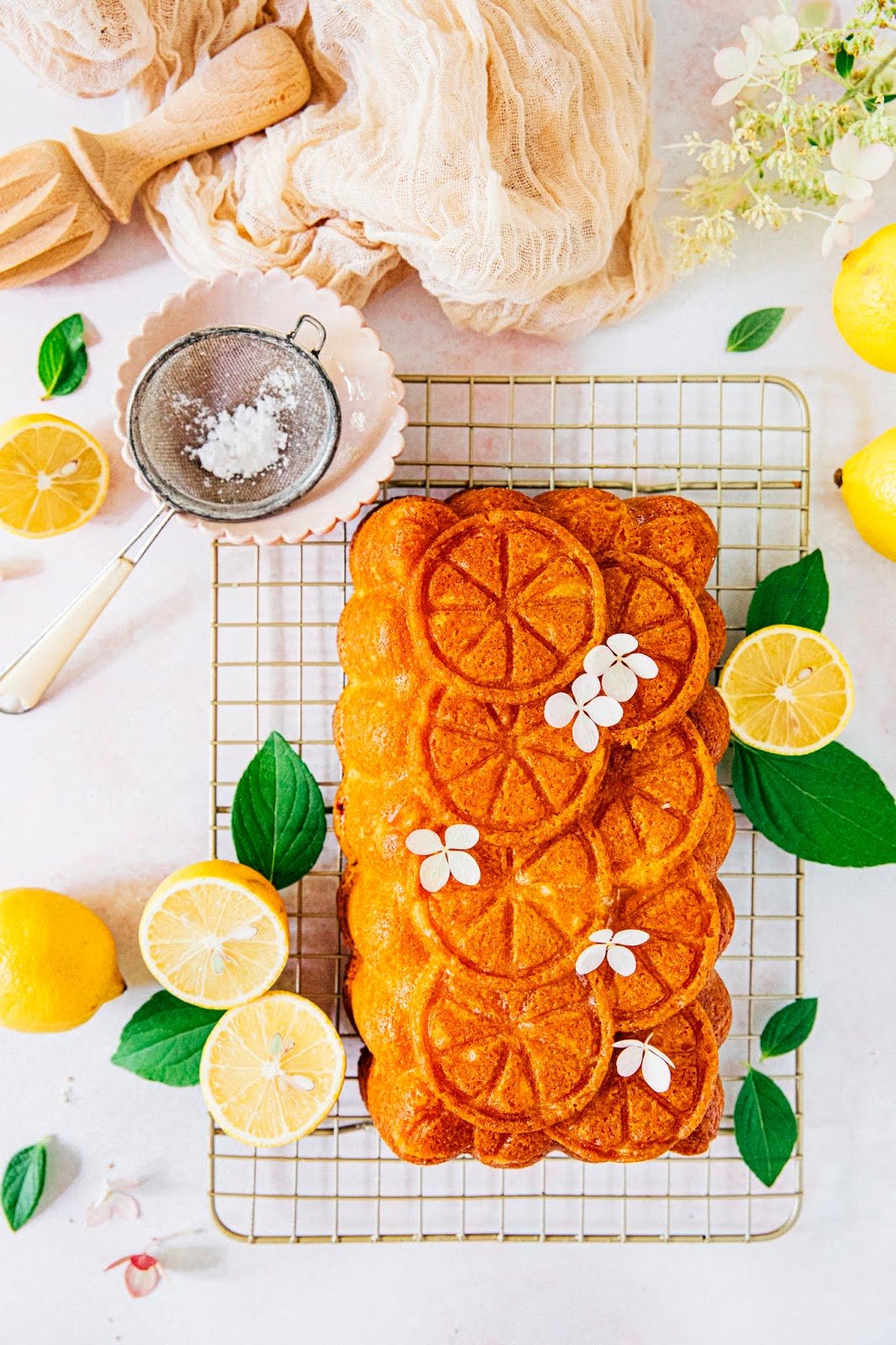
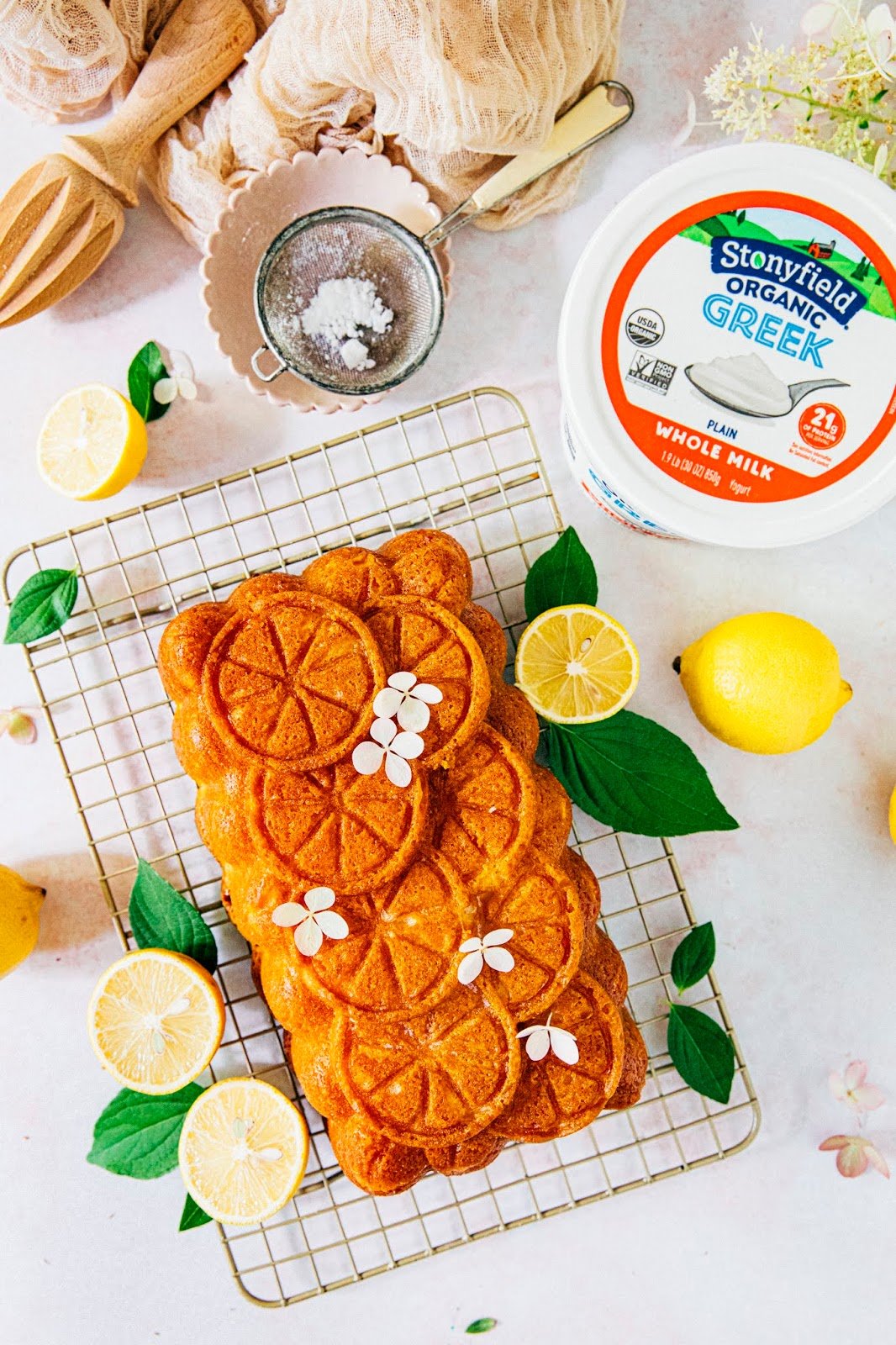
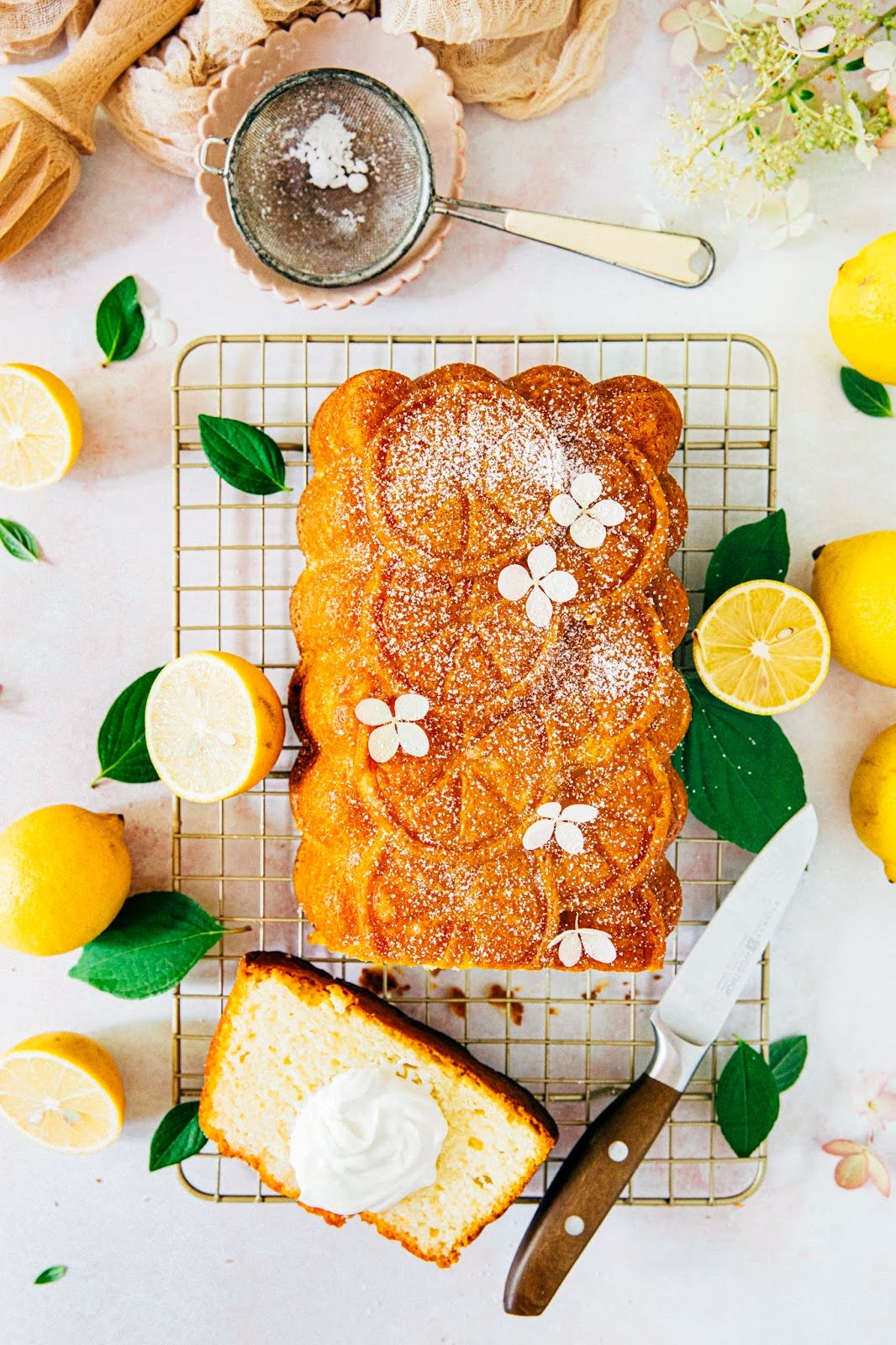

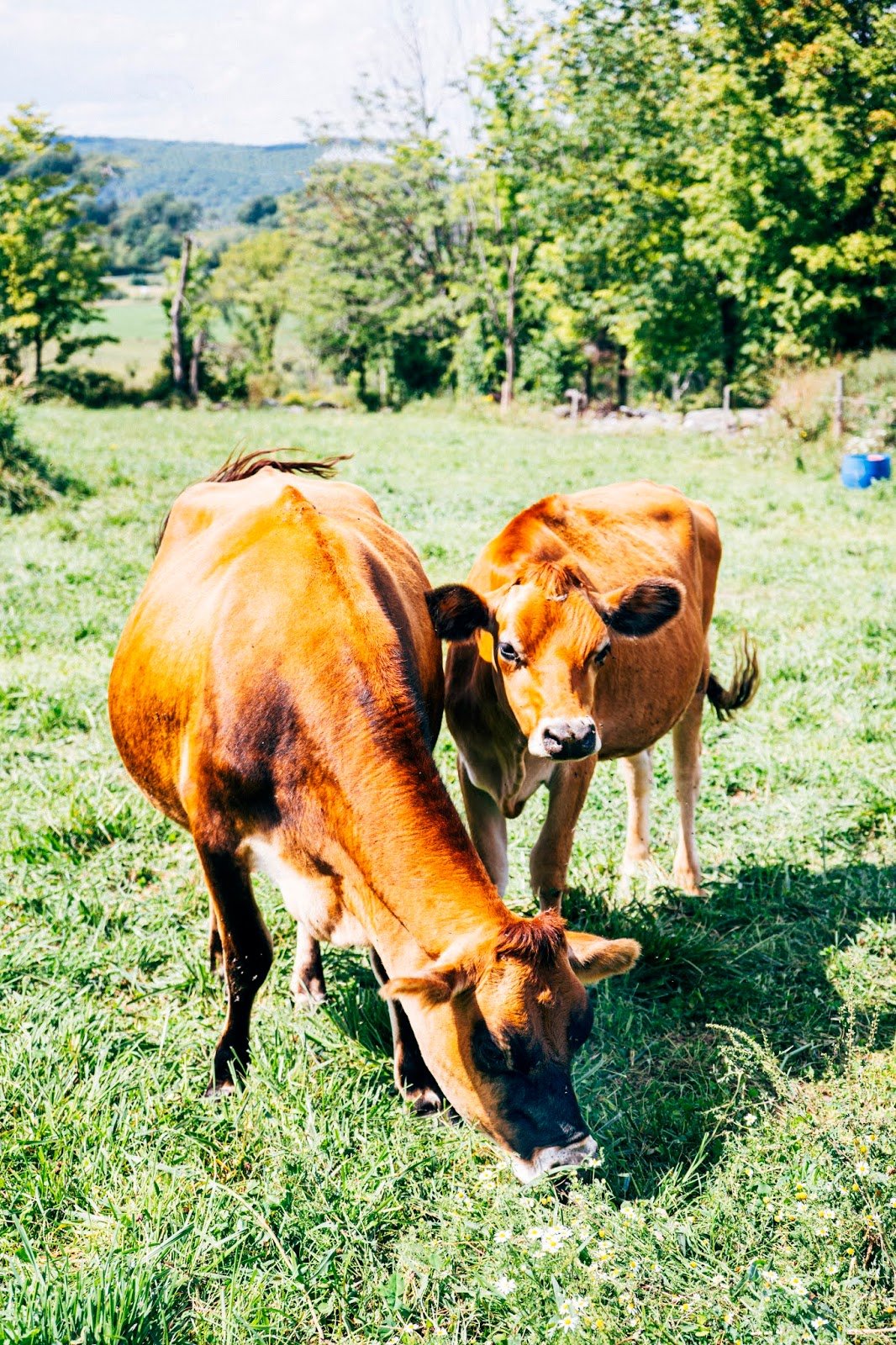
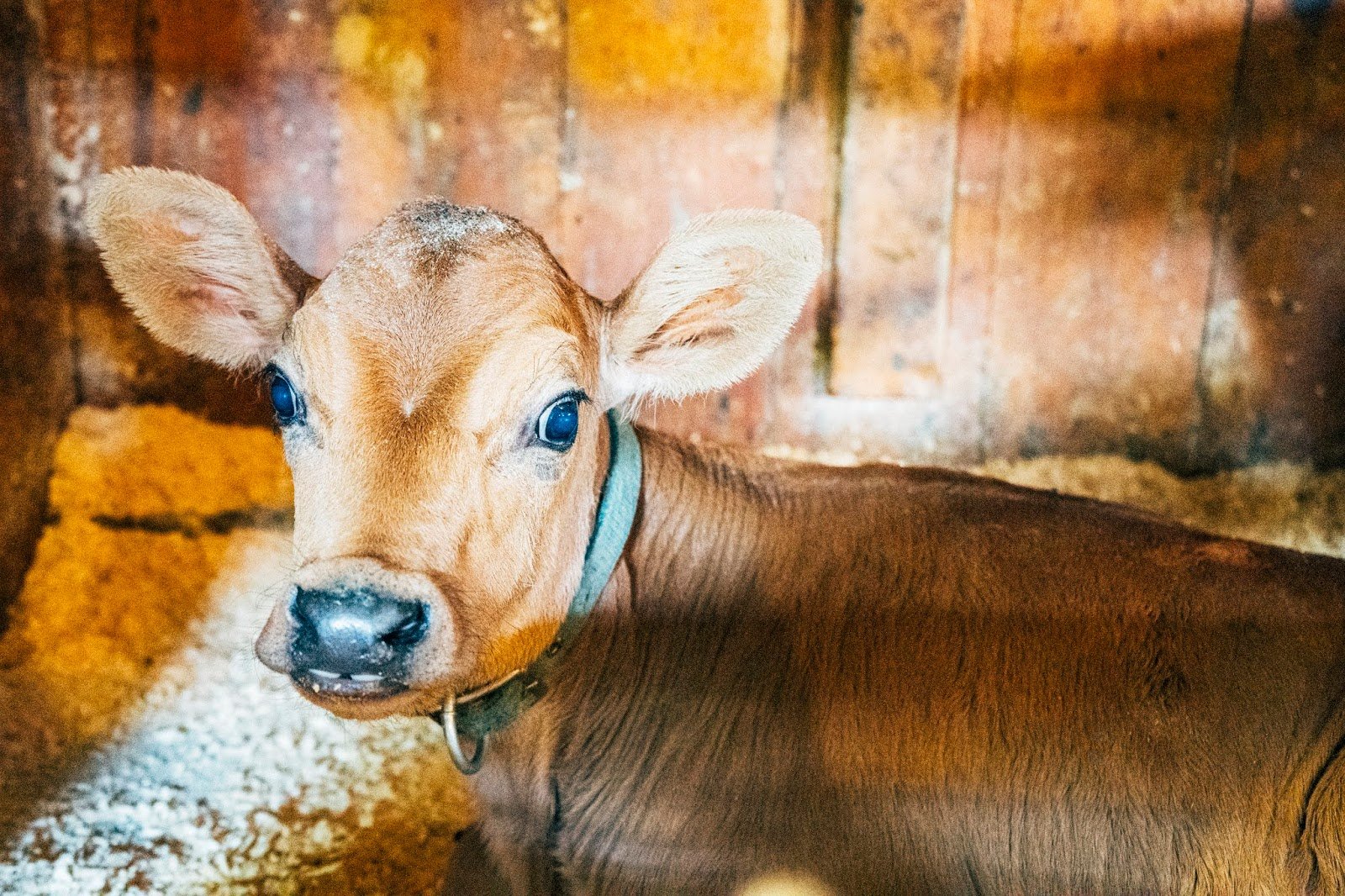
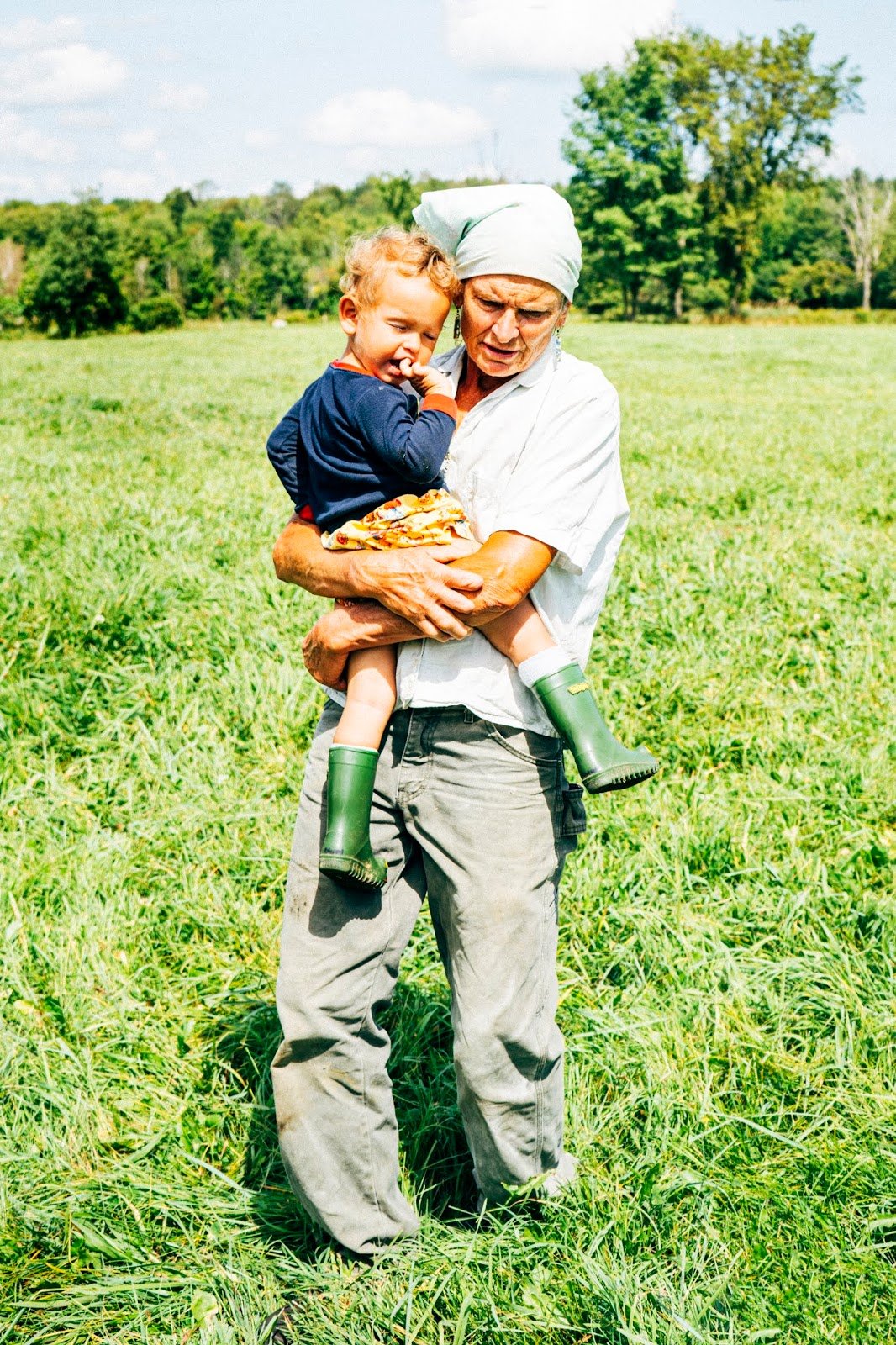

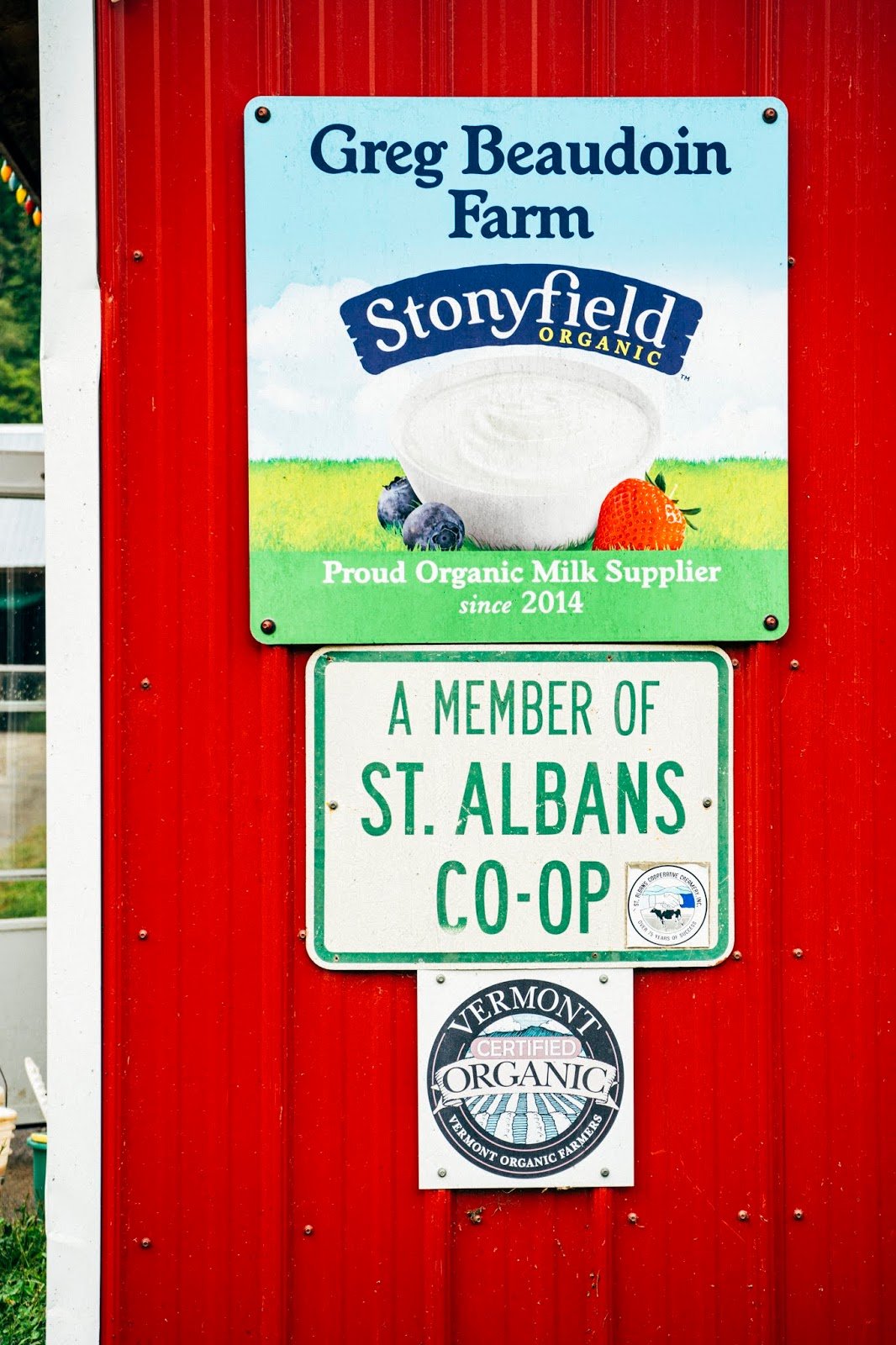
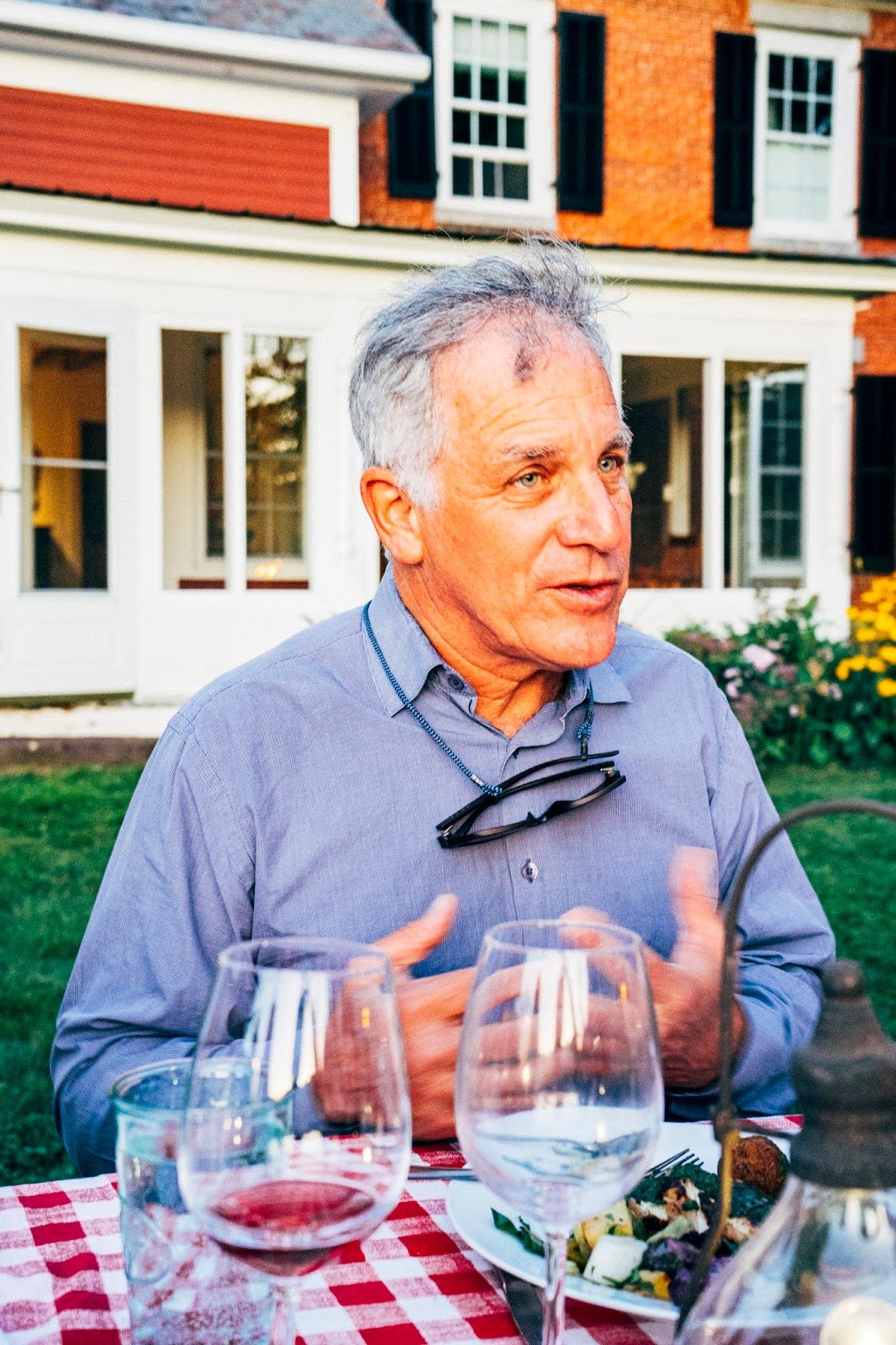
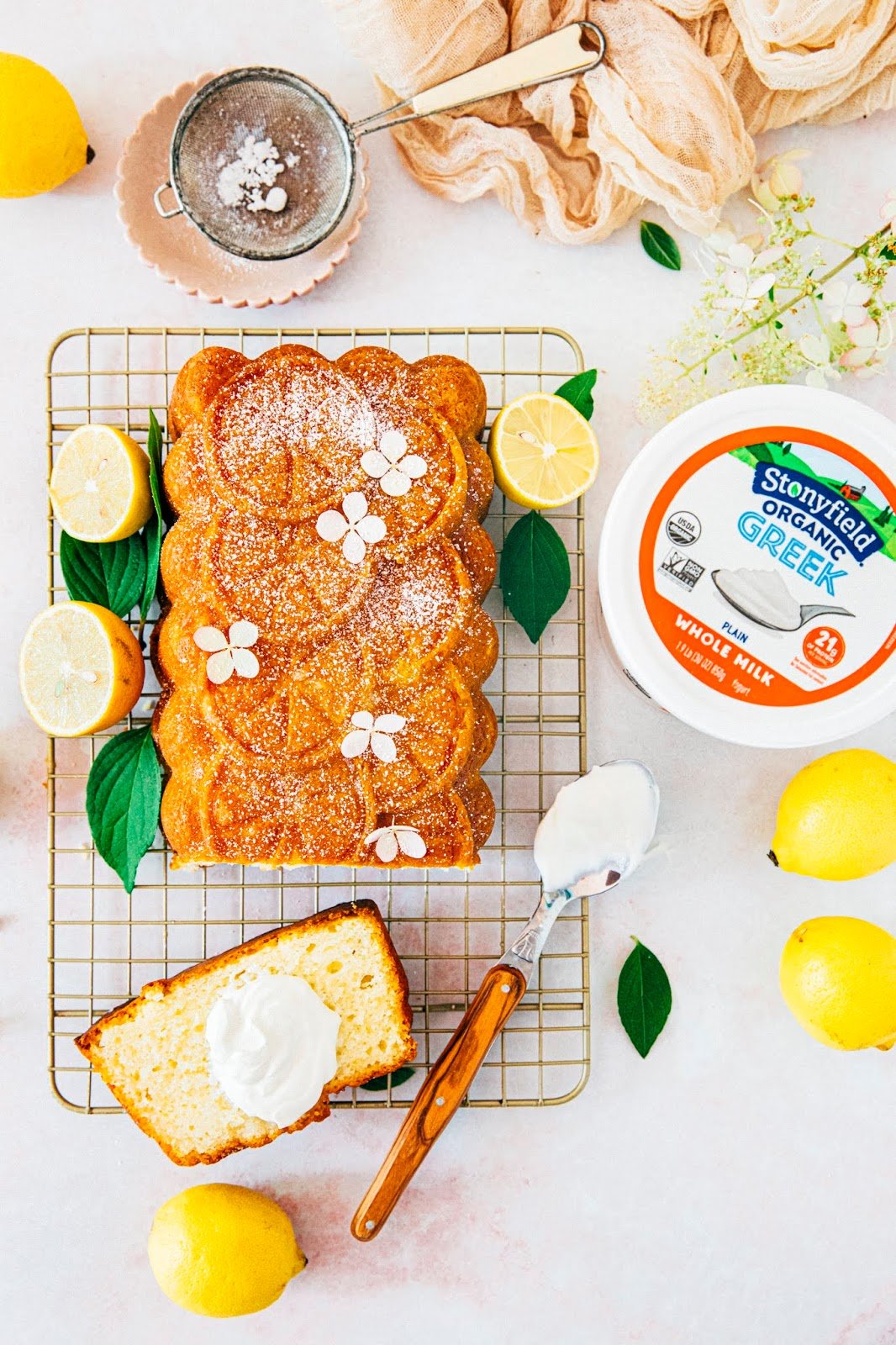


I made this cake recently and it was delicious! I just feel like the drizzle was too think to soak the cake properly… maybe using confectioner sugar instead of granulated sugar, as I did, influences the thickness of it? But overall it is an excellent recipe, nice and tangy, perfect for summer barbecue dessert 🙂
My Meyer lemon tree is having a prolific year. How much sugar would you use if I am using Meyer lemons and would still like to achieve the same tartness as using eureka lemons? Thanks for another very detailed post. The cake is beautiful with your special citrus cake pan.
Hi Karen,
I’m not exactly sure what eureka lemons are, so I don’t think I can answer this question! I looked them up on Google and they look striped with pink flesh? But it’s unclear since other sources say that they’re the same as “normal” lemons. Sorry!
I bet that this recipe will work well even with Meyer lemons tho. You may want to reduce the sugar in the syrup, but I wouldn’t mess with the amount of sugar in the cake batter itself.
I have made this cake several times and it turns out PERFECT every time!
Hands down the best lemon cake recipe ever!